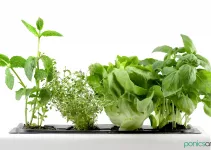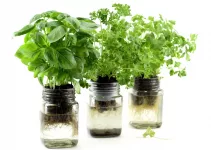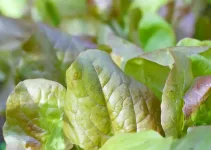For me, the idea of learning how to grow hydroponic strawberries is one of the most exciting things.
Sure, I love the idea of growing hydroponic basil and even growing tomatoes hydroponically but nothing compares to strawberries. Seeing those red hanging fruits can bring great satisfaction to an amateur grower.
They are my favorite fruit. Being able to grow them indoors is just too good to pass on. I also think it’s the perfect thing to get a lot more people interested in hydroponics, too.
The other option is to learn how to grow strawberries vertically, which is quite easy to do indoors, even in small spaces.
Table of Contents
How to Grow Hydroponic Strawberries: Indoor Gardens
1. Very good: AeroGarden Harvest Elite
The AeroGarden Harvest Elite is certainly not the cheapest indoor gardens that we could choose but it’s one of the best. It works well for strawberries because this system has the grow lights positioned so that we can only grow plants that reach up to 12 inches in height. It’s a good pick for beginners but you should keep in mind that it only has 6 grow pods and you can probably grow only 4 strawberry plants at the same time.
2. One of the best: AeroGarden Farm 24Plus
I love this one because we get 24 grow pods so we can grow a lot of strawberry plants at the same time. We also get amazing grow lights that are positioned high enough that we can even grow tomatoes, eggplants, cucumbers, peppers, etc. We also get nutrient solution and a bunch of helpful technologies. But the AeroGarden Farm 24Plus is also very expensive.
3. Amazing: Aerospring 27-Plant Vertical Hydroponics Indoor Growing System
One of the most impressive hydroponic indoor gardens is this Aerospring. We get 27 grow pods, a cornucopia of grow lights, nutrient solution, etc. And everything is wrapped up in the form of a hydroponic tower that allows maximum growth on minimum space.
How to Grow Hydroponic Strawberries: Is It Easy?
There are a lot of things to consider:
- hydroponic conditions for strawberries
- varieties to grow
- propagation aspects
- what’s the deal with pollinating them
- which are the best systems for growing strawberries hydroponically
Is it going to be easy? Not exactly. It’s a pretty difficult crop, especially for beginners. Once you gain experience with these berries, you can move on to blueberries or raspberries or maybe grape and cantaloupe, if you have a bigger system.
Hydroponic Strawberries Conditions
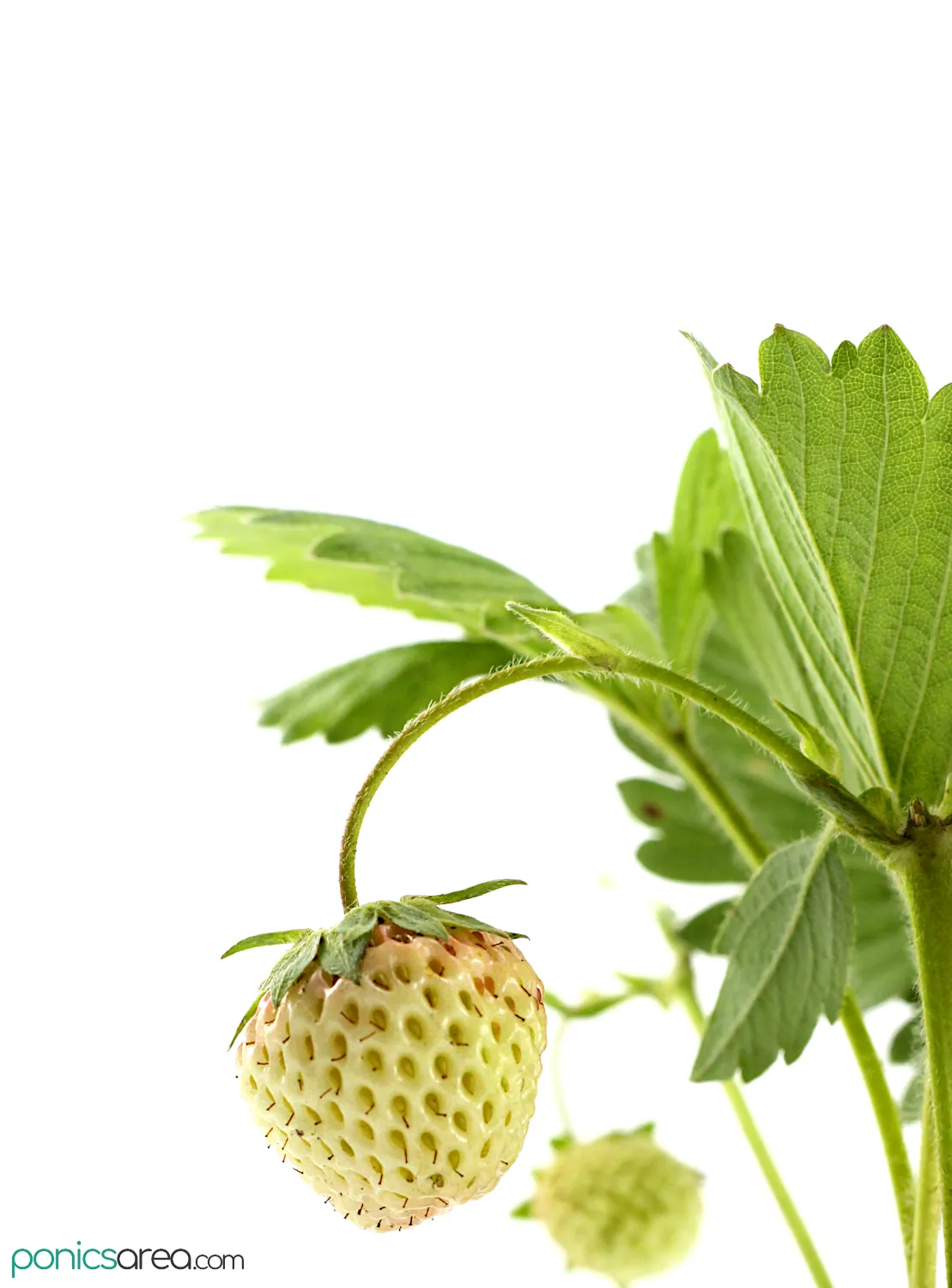
First of all, strawberries are a crop that are well suited for hydroponics because they’re small plants that can be highly productive. So, we can adapt a lot of systems for these fruits, which is great.
Moreover, they can be grown as an annual crop. Commercially, they’re grown for 5 to 10 months before replacement.
In order to achieve that at home indoors in a more simple setup, we must first discuss which are the hydroponic conditions for them. It’s our first stop in this how to grow hydroponic strawberries guide.
pH & EC
The general hydroponic pH range of 5.5 to 6.5 is good enough. A pH of 6.0 is really good.
A minimum EC of 1.6 is required. The EC can be increased if you’re growing under low-light conditions.
Temperature
The best temperatures for growing strawberries hydroponically indoors or in greenhouses are around 77 degrees Fahrenheit (25 degrees C).
For a larger range, I recommend maintaining the temperatures between 61 and 77 degrees F (16-25C).
Hot temperatures are not recommended because they can inhibit strawberry growth, loss in flavor, and increased softness with rapid ripening.
Nutrient solution
When it comes to learning how to grow hydroponic strawberries, you should know that nitrogen is one of the most important components for a large yield.
In the beginning, during the establishment and early vegetative phase, the N:K ratio is 1:1.
During the fruiting phase, they also require high levels of potassium. The levels of potassium are increased as fruits increase on the plant. The N:K ratio can reach up to 1.0:2.0.
Well, household growers who just want to grow a few plants at home should just get a general nutrient solution for hydroponics.
Where to Buy?
Check Price and User Reviews Here
Grow lights
The strawberry plant is small, it’s what we call a crop with shallow roots, but its lighting requirements are not.
They will need to spend at least 12 hours under artificial lighting. 14 or 16 hours under grow lights are not unheard of, either.
If you’re growing indoors, for good yields and big fruits, you need good grow lights, preferably full-spectrum LEDs.
Short-day varieties will be a lot less demanding, it’s in their name after all.
Where to Buy?
Check Price and User Reviews Here
Pollination
Outdoors, pollination is assisted by wind, insects, plant movement, which causes the pollen produced on the stamen to drop on the receptacle.
In order to assist strawberry pollination indoors or in greenhouses, I recommend using circulatory fans, directed at the plants.
Brushing over the tops of the plants will also facilitate pollination. It must be done daily.
If you are in the mood to buy a new tool, you can get an electric pollinator. The alternative to that is using a cheap electric toothbrush, that will produce the needed vibrations, too.
A few seconds of vibration can be applied for individual flower clusters.
Insufficient pollination results in misshapen and undersized fruits.
Spacing
A good spacing is needed, especially if we’re talking about systems that use grow beds instead of 5-gallon buckets.
A nice spacing ensures that the fruit is able to reach maximum size.
The density of the plants can vary quite a lot – you can plant anywhere between 12 to 24 plants per square meter.
Pruning
It is not exactly mandatory but it can help promote the production of more flowers and fruits if the energy is not largely focused on the big foliage.
The process is simple: lower older leaves are removed as they age. It also increases the air flow at the base of the plant and prevents humidity from forming, which can prevent fruit and crop rot diseases.
Gray mold can be prevented from appearing near the bottom of the plant by simply removing those lower leaves that create high humidity and prevent the plant from having a nice air flow.
Another thing to note is that if flowers appear before the canopy is of sufficient size, these first few flowers are removed.
Harvesting
Harvesting can take place a month after the flowers open up.
You can easily tell when strawberries can be harvested because they show clear signs: consistent red coloring and a consistency between firm and soft. If they’re too soft, they must be harvested immediately.
Hydroponic Strawberries Varieties
Commercial operations actually group strawberry plants into 2 categories:
- day-neutral
- short-day
The day-neutral ones don’t depend on day length so, they’re not dependent on receiving a lot of light. The flowering and fruiting stages are induced by high-enough temperatures.
For short-day varieties, flowering is triggered by short day lengths of less than 12 hours or by cool conditions. In industrial productions, refrigeration is used to provide the chilling period needed for flowering.
The best option for amateur hydroponic growers is the day-neutral variety. They will be able to continuously produce flowers and fruits.
If you plant them in the garden, they will produce fruits from June to mid-fall but they need to be replanted each year. In hydroponic systems, they can be kept for up to 10 months, before starting a new crop.
Plus, you need to make sure that you choose varieties that will immediately start to bear fruits, within a couple of months.
My recommendations for day-neutral strawberries are:
- Albion – it is becoming one of the most popular day-neutral varieties for commercial growers, the gold standard for flavor
- San Andreas – also very sweet, even though it has a lighter red color, one of the largest berries of any day-neutral variety
- Seascape – can be the most productive for the day-neutral varieties
- Evie-2
- Portola – has high yields but can also be less sweet
- Sweet Ann – can be quite resistant to disease, except fusarium wilt
- Keoki – produces tiny white berries packed with flavor
If you’re interested in short-day varieties, here are some options:
- Sierra
- Ruby June
- Scarlet
- Stella
- Camarosa
- Camino Real
- Chandler
- Jewel
- Sweet Charlie
Strawberry Propagation
This is where strawberries are a bit of an exception when compared to many other crops. For many, when it comes to propagation, the recommendation is to germinate seeds. That’s not the case here.
Strawberries are propagated from runners.
They’re called that because they actually look like long strawberry stems that want to run away from the mother plant. They’re very easy to spot, they’re the rebellious kid who wants to run away from home.
They form on mature plants towards the end of the growing season.
You can buy strawberry runners from nurseries or online. That’s the easy part. There are a lot of varieties to choose from.
How to Root Strawberry Runners for Hydroponics
You can buy strawberry runners from nurseries or online but it’s not easy to find strawberry runners that have been raised as plugs in soilless growing medium, those who have had no contact with soil.
If you’re buying runners that have been rooted in soil, you should rinse off all the dirt from the roots with room temperature water.
The other option is to propagate them yourself.
If you have plants in the garden and you want to root them for hydroponics, things get a bit more complicated.
You can find the visual guide for rooting strawberry runners for hydroponics here. The whole process of rooting runners will take about 20 days.
The easiest way to root strawberry runners for hydroponics is by using:
- rockwool cubes – if you don’t have rockwool cubes, you can use small pieces of cotton
- hydroponic nutrient solution
- ziploc bags – 2 inch x 3.5 inch (very small bags, big enough to fit a small rockwool cube in)
Here are the steps for rooting the runners in rockwool cubes:
- mix some nutrient solution in a small container (follow the instructions written on the packaging)
- if you only have a few runners to root, you won’t need much water with nutrients
- soak up each rockwool cube into the water – just immerse it in water for a few seconds
- place the rockwool cube into the very small ziploc bag
- pour some more water with nutrients over it – just enough that it covers the bottom of the bag but it doesn’t touch the cube at all
- cut a paper clip in two – each half will be used to hold the runner inserted into the rockwool cube
- take the bag with the cube to the runner and then take the runner and push it a bit into the cube and that’s it, in a few day it will grow roots so that it can reach that water with nutrients
In 20 days, each rockwool cube should have roots coming out of it. That’s the point where you can transplant the runners into your system together with the rockwool.
If you’re using small pieces of cotton, this is what you do: wrap the cotton piece soaked in water and nutrients around the bottom of the runner, tie it with a string, and then place it in a small ziploc bag. You can secure the bag to the stem with a few pieces of tape. The roots won’t be as impressive as the ones rooted in rockwool.
Best Systems for Hydroponic Strawberries
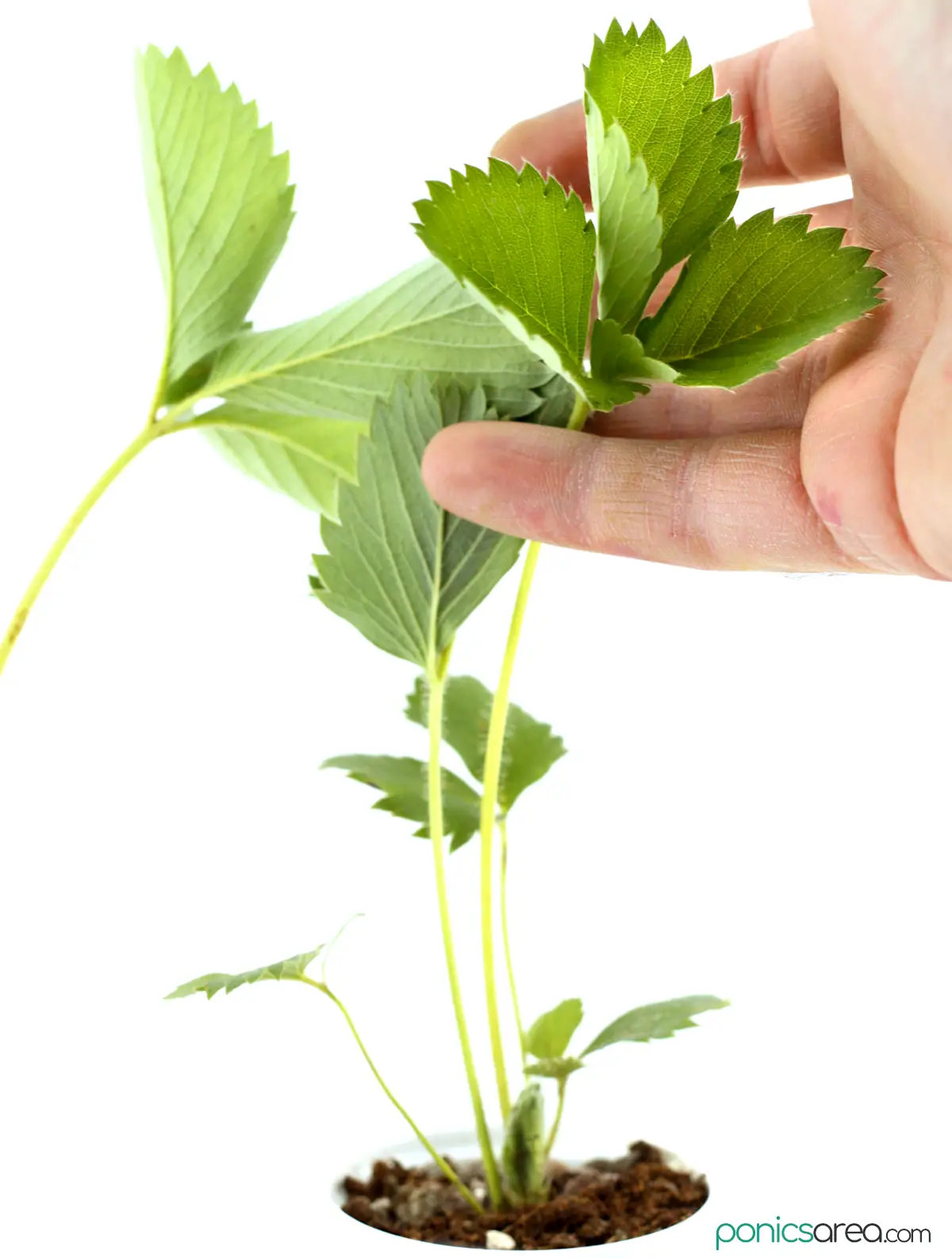
We have the usual systems, the drip and the ebb and flow are clear winners but they’re also pretty hard to build at home.
The more approachable alternatives are the DWC (good choice for more limited budgets) and the NFT.
Drip
The drip hydroponic system remains the best option for many crops, including when it comes to deciding how to grow hydroponic strawberries.
You can read my article on the drip hydroponic system, describing all that you need to build a basic setup with 5-gallon buckets instead of grow beds. There are plenty of configurations to choose from.
Another interesting commercial setup for the drip system for growing strawberries hydroponically is the stacking of pots filled with coco coir or perlite or organic mixes. Each pot has its own irrigation line and the nutrient solution drains from each via a collection channel.
Last but not least, you can grow hydroponic strawberries directly in peat bags or in bags filled with coco coir (coconut substrate).
You can have 2 rows of strawberry plants per bag, planted in diagonal. Between each two plants a drip line is inserted directly into the substrate.
I found this video if you want to see how the bags are stacked vertically. It looks amazing, it takes a bit of space but not too much. You can fit it in a bigger garage.
This type of drip system with substrate bags can be used for a variety of plants, including tomatoes, cucumbers, peppers, eggplants, maybe even for growing hydroponic beets.
DWC
On the other end of the spectrum, the DWC (deep water culture) remains one of the easiest to build.
If you’re just starting out with hydroponics then consider going for the DWC, either with linked 5-gallon buckets as containers or with a large storage tote as container.
You can use 3-inch net pots for strawberries. You can even go for 2-inch net pots or 4-inch net pots. But it also depends on the dimension of the holes that you have drilled in the lid.
NFT
A NFT with PVC pipes is a step forward from the DWC system.
Vertically stacked PVC pipes are a good option for smaller greenhouses, in case you want to grow all-year round.
They can also be placed in garages, vertical pipes don’t take that much space.
They work well for strawberries because these plants don’t grow tall.
PVC pipes for strawberries
You can go for 3- and 4-inch PVC pipes. 2-inch pipes are a bit too small for an awesome NFT.
Another recommendation that I would want to make and one that I sometimes forget to mention is that square pipes are better than the round ones.
Square pipes have the advantage that the entire tube is flooded with nutrients, the entire growing medium is covered with nutrient solution. In the round ones, the liquids can be unevenly distributed.
The advantage of a NFT is that water consistently floods the roots through the pipes. The roots will receive plenty of nutrients for rapid growth.
You can collect the excess to reuse it, thus decreasing the money spent on nutrient solution. In order to do that, set the pipes on an incline so the water flows down thanks to gravity.
You do need a water pump to send up liquids through the PVC pipes but you can work it without a timer.
Ebb and flow
If you use a timer and you don’t have the whole thing set on an incline because there’s a second tubing collecting the excess liquids, you’ve pretty much got an ebb and flow system.
Although, hydroponic growing trays are usually used for an ebb and flow.
It’s an excellent system when it comes to choosing how to grow hydroponic strawberries. You can grow quite a lot of plants, depending on the size of your growing tray.
As growing medium you can use growstones/lava rocks/pea gravel spread out throughout the grow bed and rockwool or coconut fiber on top for the roots.
If the grow beds have enough profundity, you can even grow hydroponic potatoes or beets or carrots or onions.
How to Grow Strawberries in AeroGarden
This quick guide on how to grow strawberries in indoor garden hydroponic kits applies to all the other models, not only to the ones manufactured by AeroGarden. You can use the same method for iDoo or Ezorkas or any of the other more affordable kits.
This guide can also be found on their website. It’s nicely presented. For even more tips, I also found a good video to inspire you.
Basically, if we’re talking about AeroGarden, all their models work for these plants because they don’t grow tall.
You can also buy their grow anything kit because it comes with grow sponges and nutrient solution.
Otherwise, if you’re using other systems from other manufacturers, just buy the grow sponges that work for your indoor garden and grab some general hydroponic nutrient solution or get the AeroGarden Liquid Nutrients.
Instructions
You don’t need much else besides the strawberry runners or strawberry crowns, as AeroGarden calls them.
Once you’ve rinsed off the roots of dirt with room temperature water, you can gently introduce them in grow sponges.
If the roots are small, cut the sponge down in half of its length.
On the other hand, if the roots are too voluminous for the sponge, insert them directly into the plastic grow basket that comes with each grow sponge.
That’s about it. Now you can insert them into pods, turn the lights ON and see how it goes.
Basically, you should see new growth on the plant in 7 to 10 days.
The nutrient timer should alert you that you need to add new nutrients in 2 weeks. Add them as instructed and reset the timer.
Keep the water topped up, raise the grow lights as the plants grow, keeping them 2-4 inches above the top of the plants. Don’t forget about pruning and pollination, you can check what you should do above.
The water reservoir should also be emptied, rinsed and refilled at least once a month.
Where to Buy?
Check Price and User Reviews Here
Can You Grow Hydroponic Strawberries in Mason Jars (Kratky Method)?
Yes, you definitely can. You can check out my post on mason jar hydroponics and you’ll find there a complete guide. You’ll see which components are needed and which are the instructions.
As long as you’ve got your runners, growing in mason jars is one of the easiest methods for beginners. It’s pretty affordable and it doesn’t take a lot of space.
If you want to reduce costs even more, I recommend getting the GE Lighting LED Grow Light. It’s one of the cheapest grow lights but it’s also really good and easy to use.
The Advantages of Growing Strawberries Hydroponically
If we overlook the initial cost involved into building your own system or buying a ready-built kit then, there are plenty of advantages:
- higher production, higher quality
- consistent fruit size
- the plants are kept in optimal nutritional conditions
- obtaining the best and cleanest crops
- better protection against fungi, mold, pests and bugs
That’s about all you need to know about how to grow hydroponic strawberries, they’re not exactly demanding plants but they are quite different from other crops in some respects.





